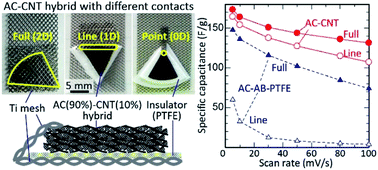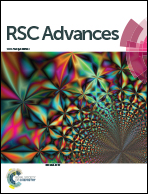Carbon nanotube 3D current collectors for lightweight, high performance and low cost supercapacitor electrodes†
Abstract
Self-supporting hybrid electrodes were fabricated through the systematic combination of activated carbon (AC), a low cost capacitive material, with sub-millimetre long few-wall carbon nanotubes (FWCNTs). After an easy three-step (mixing, dispersion and filtration) process, robust self-supporting films were obtained, comprising 90% AC particles wrapped in a 3-dimensional FWCNT collector. The 10% FWCNTs provide electrical conductivity and mechanical strength, and replace heavier metal collectors. The FWCNT matrix effectively improved the capacitance of the inexpensive, high surface area AC to 169 F g−1 at a slow scan rate of 5 mV s−1, and to 131 F g−1 at a fast scan rate of 100 mV s−1, in fairly thick (∼200 μm) electrodes. Connection to a metallic collector at the film edge only, which significantly reduced the use of metal, retained much larger capacitance for the AC-FWCNT hybrid film (107 F g−1) than for the conventional AC electrode with binder and conductive filler (3.9 F g−1) at a practical voltage scan rate, 100 mV s−1. Transport measurements in three- and two-electrode cells show that the FWCNT matrix can greatly enhance the conductivity of the AC-based films.


 Please wait while we load your content...
Please wait while we load your content...